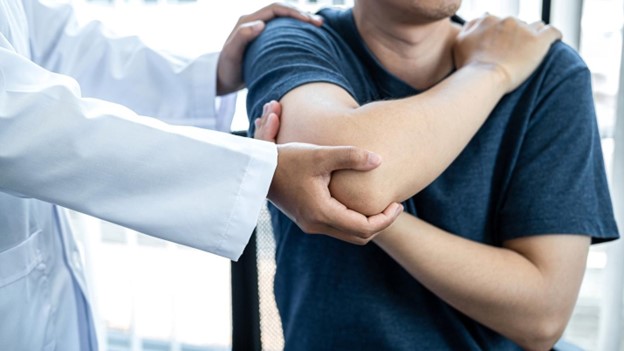 Epicondylitis is a common cause of elbow pain in athletes and the general population. It can occur at both the medial (inside) and lateral (outside) epicondyle of the elbow. Medial epicondylitis, also known as “golfer’s elbow”, commonly occurs among golfers and other athletes who repetitively stress the tendons on the inside of the elbow. Lateral epicondylitis, also known as “tennis elbow”, commonly occurs among tennis players and other athletes who repetitively stress the tendons on the outside of the elbow. Lateral epicondylitis is far more common than medial epicondylitis, occurring 5 to 10 times more frequently. The main differences between the two conditions are the location of the pain and the types of activities that cause it.
Epicondylitis is a common cause of elbow pain in athletes and the general population. It can occur at both the medial (inside) and lateral (outside) epicondyle of the elbow. Medial epicondylitis, also known as “golfer’s elbow”, commonly occurs among golfers and other athletes who repetitively stress the tendons on the inside of the elbow. Lateral epicondylitis, also known as “tennis elbow”, commonly occurs among tennis players and other athletes who repetitively stress the tendons on the outside of the elbow. Lateral epicondylitis is far more common than medial epicondylitis, occurring 5 to 10 times more frequently. The main differences between the two conditions are the location of the pain and the types of activities that cause it.
Who Gets Medial and Lateral Epicondylitis?
Medial epicondylitis is typically the result of repetitive strain from activities that involve frequent loaded gripping, forearm pronation, and/or wrist flexion. It’s most commonly seen in athletes who play golf, tennis, and baseball. It is also prevalent in the general population, occurring in carpenters, butchers, caterers, and utility workers.
Lateral epicondylitis is typically the result of repetitive strain from activities that involve frequent loading and repetitive gripping and/or wrist extension. It’s most commonly seen in athletes who play tennis, squash, or badminton and in the general population in workers who do similar repetitive movements.
Both medial and lateral epicondylitis are often precipitated by poor body mechanics, improper technique, and/or inadequate equipment or tools.
Symptoms of Medial and Lateral Epicondylitis
Symptoms of medial epicondylitis include:
- Pain at the medial (inside) side of the elbow that worsens with activities such as gripping, throwing, and forearm flexion/pronation and is relieved by rest
- Radiating pain into the medial forearm or wrist (occasionally)
- Decrease in grip strength (occasionally)
Symptoms of lateral epicondylitis:
- Pain at the lateral (outside) of the elbow that worsens with activity and is relieved by rest
- Radiating pain into the lateral forearm or wrist (occasionally)
- Decrease in grip strength (occasionally)
Symptoms of both medial and lateral epicondylitis often develop gradually but may come on suddenly when due to injury or trauma.
Treatment of Medial and Lateral Epicondylitis
Treatment of medial and lateral epicondylitis is typically non-operative and begins with rest from the activity that is causing the pain in combination with pain-relieving modalities such as ice and non-steroidal anti-inflammatory medications (NSAIDs). In some cases, bracing may be beneficial. The next step in treatment is starting Physical Therapy, which may include a variety of modalities, including ultrasound, electric stimulation, shock wave therapy, and dry needling in combination with passive manual therapy to establish full and painless range of motion of the elbow. Once full and painless range of motion is established, stretching and progressive strengthening exercises are introduced, followed by sports or occupation-specific exercises.
If symptoms fail to improve with conservative treatment options, other non-surgical treatments, including topical nitrates, BOTOX injections, platelet-rich plasma, and dextrose prolotherapy, may be beneficial.
Surgical treatment of medial and lateral epicondylitis may be indicated if there is persistent pain and weakness of the forearm for more than 6 months of conservative care. However, surgery is usually not needed.
The Role of Physical Therapy in Medial and Lateral Epicondylitis
Physical Therapy is beneficial for both medial and lateral epicondylitis. Physical Therapy helps to manage symptoms, restore normal functioning of the elbow, and prevent reinjury by improving strength, stability, and range of motion of the elbow joint.
References
- Reece CL, Susmarski AJ. Medial epicondylitis. In: StatPearls [Internet]. Treasure Island (FL): StatPearls Publishing; 2023 Jan-. Updated 2023 Apr 10. Available from: https://www.ncbi.nlm.nih.gov/books/NBK557869/
- Buchanan BK, Varacallo M. Lateral epicondylitis (tennis elbow) [Updated 2023 Aug 4]. In: StatPearls [Internet]. Treasure Island (FL): StatPearls Publishing; 2023 Jan-. Available from: https://www.ncbi.nlm.nih.gov/books/NBK431092/
- Erdem Y, Neyisci C. Lateral and medial epicondylitis: Definition, diagnosis, screening and treatment algorithms. Work-related Musculoskeletal Disorders. IntechOpen; 2019. doi: 10.5772/intechopen.81915.
